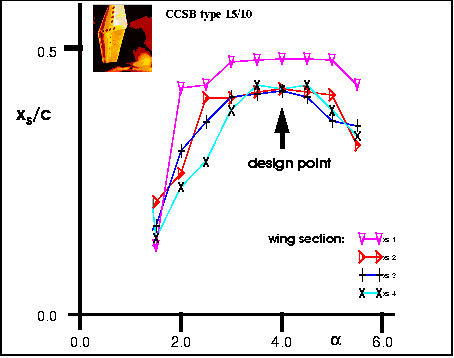Typical Application of Run-Time Evaluation
The results obtained with the run-time data evaluation system will be briefly illustrated using a typical example. One of the selection criteria for defining a set of flow parameters allowing for valid aerodynamic testing with corrected scale and wing clip influence was the position of the shock wave on the upper surface of the wing. For the design point of the CCSBs the shock should be parallel to the trailing edge of the wing.
Fig. 5 Automatic evaluation of shock position for Ma=0.74 and CCSB type 15/10

The software provides extraction of the shock position by analysis of the steepest gradient in the pressure distribution. This is performed for all measured cross sections of the wing. Fig. 5 shows a comparative visualization of the shock position xs versus chord length c of four different cross sections plotted against angle of attack a. The wing sections are numbered 1 to 4, number 1 being the closest to the aircraft body. When the CCSBs fit optimal to the flow conditions three of the shock positions coincide, indicating a shock at x/l=const.or generally speaking a flow on top of the wing equivalent to an unclipped wing. The inner wing section (xs1) is not expected to follow this trend because of the significantly different cross section.
Such evaluation quickly proved the feasibility of the experimental approach. In the meantime a series of tests has been conducted successfully using the F9 model and the software described above. Scientific evaluation of these test will be subject of future publications.




